|
|
 |
 |
 |
 |
Canalys Navigation Forum USA 2008
|
Date 26th November 2008
|
Introduction
The Canalys Navigation forums started in Geneva, Switzerland in 2006. They have grown into an international series of events with forums in India, Taiwan, Hungary and America this year.
The Navigation Forums are targeted at professionals in the Navigation industry and cover all aspects of the SatNav industry from Market Trends and Financials to predictions in the direction of the technology and volumes.
The USA Canalys Navigation forum was held in the technology centre of America: Silicon Valley. Held the week before Halloween it just happened to be located near one of the big Pumpkin production areas at Half Moon Bay, California. Coupled with a mountain lion on the road, this caused some interesting traffic problems getting there.
The Canalys Navigation Forum took place over 2 days with a series of Keynote Speeches, Panel Sessions and Networking opportunities. The climax of the event was 18 holes of golf on the spectacular Pacific Coast Golf course. |
Article by Mike Barrett


|
Keynote Presentations
Steve Brazier Canalys CEO:
Finding Profits in the value chain.
Steve's Keynote speech covered the core financials underpinning the GPS industry along with an analysis of the pricing and features required to move forwards.
The key financials indicate that currently the technology industry is not affected by the crisis in the financial industry, though that may follow. The key players in the technology industry are still growing. The markets with the most growth are India and China, and the companies with trade and investments in these emerging countries are faring better than those in the mature markets.
Steve says "We have achieved peak profitability". This means that the GPS industry has matured. Manufacturers now need to look for other ways to maintain profits. Currently the Gross Margin is about 40% the main challenge is how that can be maintained and not become like the personal computer model where only 10-11% is achieved.
There needs to be a switch to software and services to maintain the profits. This will be achieved with connected PNDs. GPS will become ubiquitous amongst devices in the next couple of years. The industry needs to move to embrace this shift. Apple and the Appstore have shown the way to go both in pricing and command of the market.
Canalys see the main way to retain profitability is the introduction of a new sales channel: the Telco operators. With prices and profits falling the Telcos could be the saviour of the PND, possibly using the model of subsidisation (as currently experienced for Laptops in the UK).
The achievement of peak profitability will see mergers and companies exiting the market. This has already happened with TomTom and Tele Atlas, Nokia and Navteq, Mio and Navman, and in the last few weeks Dash and MyGuide have left the market. Dash will now sell services.
Steve also examined the prices of Maps questioning the pricing structure. Why do map upgrades cost about $80 when the initial cost quotient in the PND is only $14. Again citing the Apple Appstore example: Why not sell map upgrades at a more realistic $2 or $5 and gain customer loyalty and possibly up sell other data or services at the same time?
The videos to the right have been split into 2 summary videos the first detailing the Industry Financials, the second pricing and features. The summaries offer little context so please watch the full video to get the proper context of the sound bytes. |

Steve Brazier Keynote summary: Industry Financials
Click here for quicktime video
Click here for Windows Media video
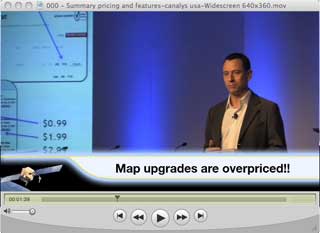
Steve Brazier Keynote summary: Pricing and Features
Click here for quicktime video
Click here for Windows Media video

The full keynote speech from Steve Brazier
Click here for Windows Media video |
Chris Jones Canalys VP :
What's around the corner?
Chris started his keynote with a Data Blitz showing us a whole bunch of figures, stats and projections in 5 minutes... Guess what I cant remember them all...
One of the key figures was that there are 50,000,000 navigation solutions in use, and despite those figures we still have only 10% of US drivers using navigation.
Chris was another speaker with praise for Apple. This time for the user interface. Apple have created an easy to use product that has been implemented Worldwide.
Nokia expect to ship 35,000,000 phones with embedded GPS in 2008. However the Nokia N95 had some serious problems, but learnt very quickly from their experiences.
Pedestrian navigation attributes have been collected by mapping companies and are now starting to be integrated with
Geotagging is going to become prevalent. Geotagging is not just about images, but in the future all your data could be geotagged: Contacts, Calendar entries, meetings etc.
GPS devices can be used as probes for traffic information. We have already seen Dash implement a solution based on this technology, and now both TomTom and Navteq have device based probe data available.
Once again the summary is heavily edited, watch the full keynote for the correct context.
|
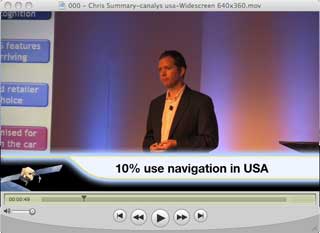
Chris Jones Canalys USA Keynote summary
Click here for a quicktime (mac) video.
Click here for a Windows Media video
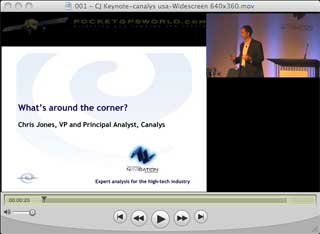
The full keynote speech from Chris Jones
Click here for Windows Media video |
Rachel Lashford Canalys MD APAC:
The Smartphone direction
Rachel Lashford's keynote speech was much more focused on the Smart Phone area of the market.
Rachel looked at the spread of Smart Phones. The largest region for Smart Phones is Europe this is led by Nokia who shipped 12,700,000 phones in Q2 to Europe. Europe is still growing strongly at 27%. RIM dominates the US Market with over 50% of the devices.
Japan on the other hand is in decline from the handset point of view with operators reducing subsidies but looking to increase revenue from other areas such as data and services.
Development communities are split into camps: Nokia launches the Symbian Foundation to create an S60 community, Android from the open handset alliance led by Google, and limo. These are then split with support from various Telcos.
Apple leads the touch screen revolution with the iPhone. This is being followed by the introduction of the Android phone, and new Blackberry models.
There is a suggestion that pedestrians will not need Turn by Turn navigation. The most common mapping solution across all platforms is Google Maps. It is great for companies like Apple and Nokia who do not have service strategies of their own.
Rachel says "Google can also provide a gateway to its own branded services..." "Coupled with Android it (Google) has its own ecosystem owning even more of the enduser".
|
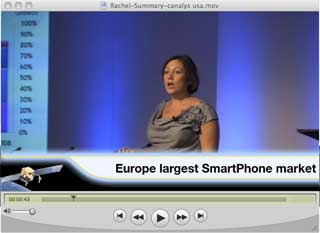
Rachel Lashford's Canalys USA Keynote summary
Click here for a quicktime (mac) video.
Click here for a Windows Media video.
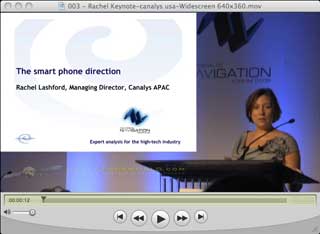
The full keynote speech from Rachel Lashford
Click here for Windows Media video
|
Panel Sessions
What navigation solutions will we be using in 2012?
With 3 of the 4 panellists involved in connected devices it was no surprise that online devices were the main feature of this panel.
Phones and PNDs will co-exist in the short/middle term, with the focus of functionality being Navigation for PNDs and Location Based services for mobile phones. In the longer term the mobile phone may dominate particularly with devices such as the iPhone and Android.
Local search and local based services will be a major factor in the usage of Mobile connected solutions, particularly in the social arena and real time services. Telco Operators are holding back the market, but with more open platforms becoming available location online is becoming less of a barrier.
|
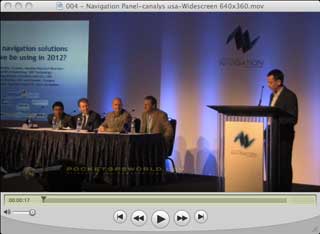
Click here for a Windows Media video
of the panel session. |
The types of service will change from navigation to location and time specific data. Navigation will be a layer of your life. This includes things like traffic, local fuel pricing, movie times, etc. As well as your device telling you when you have to leave to make your meeting. Pricing models need to change as well, maps are too expensive for mobile users.
With service providers knowing your route and the timing points on your route then location and time context sensitive information can be delivered to your device. This does of course raise some issues of privacy which need to be incorporated into product design.
Pedestrian navigation has different priorities in different countries. In Europe and Asia users are more likely to walk or use public transport. In the USA the users, with a few exceptions, are more often moving in cars. 2009 is likely to be the year that the technology will be in place for these features, with the iPhone type client using it commonly in 2010, other general users in 2012.
There is a new pricing model required. It is difficult to add new services to a product and pay for them. Currently there is no successful advertising model in mobile, and it is not practical to add $1 or $2 for additional features to an existing product.
|
What technology will be in next-generation navigation solutions?
This panel was much more diverse ranging from multi-modal positioning, to antenna technology, to Intel.
Connected PNDs are being held back by the business model. What should the user experience be? Should you have to contact the Telco to activate or should it work straight out of the box from a mass-market reseller?
The iPhone has introduced new positioning technologies such as WiFi and Cellular as well as GPS. This will help with indoor location services.
New antenna technology will improve the user experience. Navigation can take place using voice instructions with the device in a pocket. |
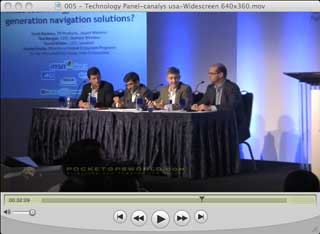
Click here for a Windows Media video
of the panel session. |
We heard a lot about the Mobile Internet Device (MID) from Intel, who, not surprisingly, expect that the Intel based MID will be the device of preference for the future. Justification for this was that the MID is a standards based device and will work with and website on the network.
Web based applications may be a couple of years away as the capability to acquire a location and communicate with the device's hardware are not standardised yet. Plus there is the issue surrounding the varying sizes of display resolution.
Indoor positioning using multiple radios (WiFi, Cellular, GPS) will be prevalent in the next 12 months, but battery life is an issue. Power consumption is the biggest concern for the manufacturers. Using the combination of radios can help with power usage, but not for constant usage.
Going forwards a Global Cellular network will be required. In the US the roaming boundaries have been removed, but these still remain in Europe. For truly connected systems to work effectively we need to move towards global networks.
|
What dynamic content do users really want?
The most valuable real time content is traffic, closely followed by fuel pricing, tourist information and other live data such as weather.
A survey indicated that LBS services are a higher priority to users than multimedia. This would mean a shift in focus for operators.
Local search is a high priority, allowing the user to perform searches based around a certain location.
Although traffic is the "killer app" it is still in its infancy, and has a bad reputation from the past. It has now reached a quality level where users can have a better experience with reliable data. |
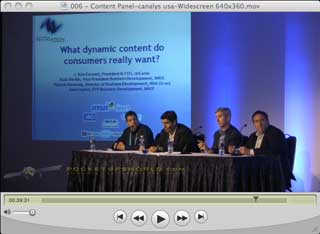
Click here for a Windows Media video
of the panel session.
|
The user experience of traffic information is not just about the data that is collected on the roads, but it also reflects the integration into navigation applications. Mobile phones have been ahead of the game as they have the connectivity for live data delivery, but PNDs are starting to catch up. The PND provides a richer more meaningful environment for traffic integration.
Ultimately the goal is the integration of lots of varied location based content allowing the use of social networking and more leisure style activities. Currently it is imagined that the services will be subscription based, but may be come advertisement based. The challenge is that customers want perfection, they want it for free and they want it now!
A survey has shown that users prefer a monthly pay model rather than pay as you go or advertisement models. This does need to be based on compelling content that the users want to use on an ongoing basis. The value of the added content needs to be 'sold' to end users so that they can understand the value of the additional services. This may be achieved by providing free trial periods for the content.
|
People, Places, Communities
The questions where are you? what are you up to? are the
Barriers to online mobile communities are the number of people on data plans, the cost of using data, there is a lack of compelling applications, mobile Facebook, Loopt etc are not there yet. The social networking can be a viral application but market share is still small. The hardware platforms are still not prevalent enough yet and more connected smartphones are needed to hit a critical mass.
Privacy is a key factor in the social community arena. The services need to be permissioned based with sufficient anonymity built in. With the new privacy legislation the position of applications is clearer and guidelines are in place for products.
|

Click here for a Windows Media video
of the panel session.
|
Apple have built a good eco-system to allow developers to create and distribute applications easily, compared to Wireless Carriers where there is a requirement to support a large number of devices. The carriers have a lot of power to push and advertise applications. Carriers like existing brands like MySpace and Facebook. Carriers are only interested in commercial applications and are often lowest common denominator applications.
We are now seeing apps that try to integrate or span social networks to add value to the user's content. This comes in the form of new applications working with your current networks.
Mobile advertising is a potential way to monetise the social networking as there is no current suggestion that these will be successful as subscription based services. It is a difficult question to address as there is no standard to measure by. Mobile advertising is embryonic and untested. There is no guarantee it will be successful.
The exciting areas of social networking come when it evolves as a business development tool. Imagine being at a tradefair with a spare evening. Being able to see which of you contacts is in the same city can be really useful to "create opportunity out of dead time".
|
Networking
One of the most important parts of a forum like this is the networking. The Canalys Navigation Forum schedules lots of time to mull over the presentations and to get to chat to other members of the industry. It is not often that most people get an opportunity to talk to the captains of the navigation industry, but here you do.
There was an exhibition hall open during the networking time. This housed a number of sponsors displaying their products and services.
|
Conclusion/Commentary
The inaugural Canalys Navigation Forum in the US was a big success. Having the opportunity to to discuss just about everything in the GPS Industry for Market Share and capitalisation, to forecasts of potential volumes and discussion of the developments in the industry is priceless.
The main messages that came from the Forum were that our cut-throat pricing market had reached maturity in just 3 years and is at a tipping point for creating profit within the markets. Moving forward we are going to see a lot of consolidation (which has already started), companies are going to start exiting the marketplace, and the remaining companies need to find other ways to retain the profit. This is starting to be seen with connected PNDs and the explosion of touchscreen smartphones such as the iPhone, Android G1, and the new Blackberry devices.
The sector that could 'save' the industry may very well be the Mobile carriers who if (when) they enter the marketplace in a meaningful manner could bring new charging mechanisms and possible subsidisation of hardware into the arena. An alternate scenario is that the telcos get left providing the conduit and the hardware providers provide the application platforms.
On the Smart Phone (and even PND) side of the market there is a lot of conversion occurring with displays getting larger and more user friendly. Touch screens and GPS is becoming more prevalent. There is a "danger" that we may see the domination of the mobile sector by Google. With the introduction of the Android open platform the Google search and other services form the core of the system. This may leave 3rd party developers and other service providers struggling to find a business model to monetise their products.
It may be that the GPS industry is "stuck between a rock and a hard place". There is the possibility that profit can be retained by partnering with the Telco companies, this could result in a vast reduction of providers, and more restrictive processes to get a product to market. On the other hand the GPS industry may be faced with shrinking profit margins where the only way to retain profit is via additional services that users currently seem reluctant to pay for. An interesting problem that will no doubt be solved in some innovative ways. |
|
| Comments
|
 Posted by Fellwalker on Sat Nov 29, 2008 9:23 am Posted by Fellwalker on Sat Nov 29, 2008 9:23 am |
 |
Mike
Thanks for bringing all of this incredible detail from the canlys event. Its fascination stuff.
Do you have any copies of the slides as I would MUCH rather have been able to see the slides as presented, whilst listening to the presenter. I appreciate this may be down to the copyright of the event. BUT, seeing the presenter did not add anything.
Jim
Samsung Galaxy Note 9, Nexus 5, Galaxy tab S3. Also use OSMAnd+, Sygic Mobile Maps, and OS maps app. Also "Great Britain Topo Maps" and "Old Maps". Don't use speed camera database as sticking to the limit is safer. |
|
|
|
 |
|
|
 |
 |
 |
 |
|
|